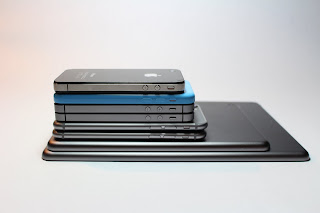Smartphone
The smartphone refers to a mobile phone with advanced features that are similar to those of a computer: browsing the Internet, playing video, music, video games, email, video conferencing, light office ...
Equipped with a powerful processor, often multicore, it embeds a series of sensors (compass, accelerometer, gyroscope, GPS) that allow it to run applications dedicated to physical activity, assisted navigation and games that the you can control with a simple movement. Smartphones are usually equipped with a video camera and a front camera whose performance continues to progress.
 |
| Smartphone & Phablette © PEXELS |
The arrival of the Apple iPhone has changed everything
The IBM Simon released in 1994 can be considered the first smartphone. The years 1990-2000 saw the dominance of several historical manufacturers like Nokia, Ericsson, LG, Samsung and the Canadian Research In Motion with the BlackBerry and its keyboard azerty / qwerty miniature. At that time, smartphones are considered and perceived as professional tools.
The year 2007 marks a turning point with the launch of the iPhone by Apple. Equipped with a multi-touch screen and the iOS operating system with its downloadable applications on an online store (App Store), it brings the smartphone into the mainstream.
Samsung and smartphone sales
Intuitive touch interface, fun uses and communication (instant messenger like WhatsApp, Snapchat plus social networks such as Facebook, Instagram, Twitter ...) quickly imposed the smartphone on an ever wider audience.
In 2015, it sold 1.4 billion smartphones worldwide (source: IDC). Samsung held the lead in sales followed by Apple and several Chinese brands (Huawei, Lenovo, Xiaomi).
The phablets rise in power
Phablettes, these big-screen smartphones (between 5 and 6.9 inches diagonally) are playing an increasingly important role in the market. This trend is also accompanied by technological bidding with the introduction of biometric readers (fingerprint, facial recognition), contactless payment systems, Ultra HD photo-video sensors and even 3D cameras.












No comments:
Post a Comment